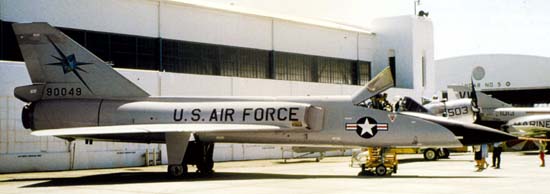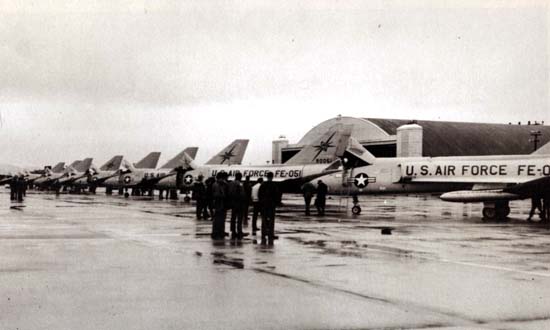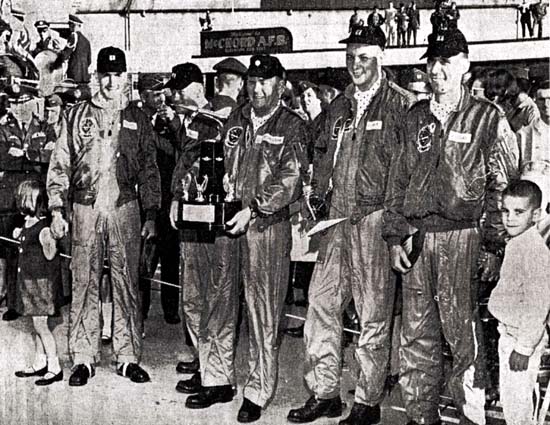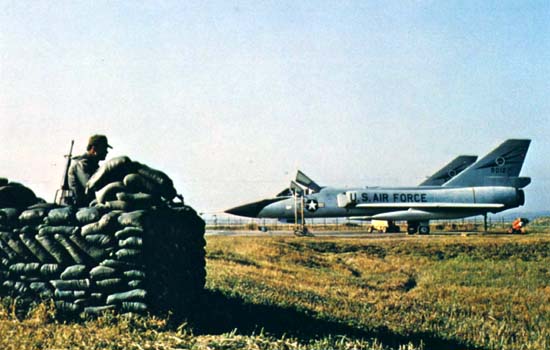|
|
|
THE F-106 ERA (1960 - 1983) |
|
AIR DEFENSE COMMAND (1960-1968) |
|
|
 |
|
PICTURE FROM "USAF
INTERCEPTORS" BY MARTY J. ISHAM & DAVID R. McCLAREN |
|
The "Ultimate Interceptor"
the Convair F-106 was flown by the 318th FIS for almost 24 years.
|
|
|
|
Many changes were in
store for the 318th in the month of March 1960. On 15 March, the 64th
FIS flying F-102's changed stations, moving from McChord to Paine Field
near Everett, WA,
the squadron had been co-located at McChord with the 318th since 15
August 1957. The largest change for the 318th occurred on March 24,
1960, as two of the USAF's most advanced Interceptors, the Convair F-106
Delta Dart (s/n 59-0050 & 59-0051) landed at McChord. The F-106 fresh
off a World Speed Record of 1,525.95 set on 25 December 1959, replaced
the squadrons F-102A / TF-102A Delta Daggers.
|
|
|
|
The F-106, equipped with
advanced fire control system that, in concert with the SAGE radar system
(activated at McChord in 1960), could automatically intercept
approaching enemy intruders. Lastly, 325th Fighter Group would
deactivate on 25 March ending a 15-year relationship with the 318th that
began in WWII. With the deactivation of the 325th FG, the 318th would
directly report to the 325th Fighter Wing.
|
|
|
|
With all of the changes
at the squadron, many felt a new tail design was needed to match the
performance of the new fighter. In June of 1963 the "North Star"
insignia was born devised by 318th pilot 1st Lt. Gary K. Carroll who in
1971 the then Major would win a Distinguished Flying Cross while flying
a forward air control mission over Southeast Asia.
|
|
|
|
On 1 July 1963, the
Green Dragons would share the ramps of McChord with another F-106
squadron, the 498th FIS "Geiger Tigers" from Geiger AFB, near Spokane,
WA. A seasoned unit in the F-106, the 498th was the second squadron to
receive and the first to become operational and stand alert with the
aircraft.
|
|
|
 |
|
PHOTO FROM
"CONVAIR F-106 DELTA DART" BY WILLIAM G. HOLDER |
|
F-106's from the 318th &
498th Fighter-Interceptor Squadrons arrive at Elmendorf AFB, AK to stand
alert in "Operation White Shoes". To streamline maintenance and training
at McChord, the 498th (exchanged their older F-106's with the newer
model of F-106 from the 456th FIS in Oxnard AFB, CA, which flew a
similar model as the 318th FIS.
|
|
|
|
On 15 July 1963, in a
effort to strengthen the air defense of Alaska, ten F-106's from the
318th & 498th Fighter-Interceptor Squadrons would deploy to Alaska
supplementing the F-102's of the 317th FIS. The operation codenamed
"White Shoes" would call for the squadrons to maintain 24-hour strip
alerts at Elmendorf AFB, King Salmon, and
Galena
Airfields.
|
|
|
|
F-106A’s on alert in Alaska routinely
intercepted Russian long-range reconnaissance aircraft including an
occasional “interaction” with Soviet MiG-21’s. On 8 September 1963,
deployed F-106's would intercept two Soviet TU-16 "Badgers" bombers over
the Bering Seas
off the northwest coast of
Alaska. The 318th and 498th flying in Detachment
1, 325th Fighter Wing, maintained a continuous rotation until December
1965 in this operation (later renamed "College Shoes"). Additional F-106
squadrons across the Air Defense Command assisted in this deployment
until its end in October 1970.
|
|
|
|
During the increased
operation tempo of the White Shoes deployment, the 318th was proficient
enough to win the shoot-off competition named Operation Runway, an event
that gave the chance to compete in the 1963 edition of the William Tell
Weapons Meet. The skillful airmanship and great maintenance
of the Green Dragons continued at William Tell, with the unit winning
the F-106 Division of the event, with the 318th being named as the
"World champion F-106 Squadron". Two years later, the Green Dragons
would compete in William Tell 1965, unfortunately not with the same
result; the squadron came in 4th place.
|
|
|
 |
|
PHOTO FROM THE TACOMA
NEWS TRIBUNE |
|
Green Dragons return home
victorious after winning the F-106 category of the 1963 William Tell.
(L-R) Capt Alan L. Lomax, Capt Charles Schaut (team alternate), Lt Col
Howard S. Askelson (Team Leader and Sq Commander), Capt Lawrence D.
Haight, and Capt James M. Jordan (not pictured - Capt Donald R. Thiel,
second alternate)
|
|
|
|
In September of 1965,
Detachment 2, 325th Fighter Wing was established at Walla Walla
City/County Airport in Washington State. The 318th & 498th
Fighter-Interceptor Squadrons assumed the alert responsibilities in the
southeast Washington
area performed by the Portland
based 337th Fighter Wing. Air Defense unit had maintained presence at
the airport since 1962. In June of 1966, the 498th FIS would transfer
to Paine AFB replacing the Southeast Asia
bound 64th FIS With the move, the 498th would be realigned under the
57th Fighter Group at Paine.
|
|
|
|
During the mid to late
60’s, modifications to increase the capabilities of the F-106 were
underway, with two of those upgrades, supersonic wing tanks and
in-flight refueling, being added in late 1967, with the F-106's of the
318th being the first unit. On 20 November 1967, ten Green Dragon
F-106's using their new in flight refueling capability, flew a non-stop
flight from McChord to Tyndall AFB FL successfully intercepting drone
targets with live air-to-air missiles. The squadron's mission was the
longest non-stop flight for the F-106 at that time.
|
|
|
|
On January
15, 1968, Air Defense Command was redesignated as Aerospace
Defense Command (ADCOM), this change was a result of the Commands
shift of focus from bomber defense to a an expanded mission detecting
and tracking ballistic missiles, space satellites and enemy aircraft
over United States airspace. With these new tasks in mind, ADCOM
developed a plan to prepare their F-106 squadrons for potential
combat. In 1967 program named “College Cadence” created an ADC quick
reaction force from the 318th and 3 other Fighter-Interceptor Squadrons.
At a moment's notice, the aircraft could be call upon in an emergency.
That situation came about early 1968.
|
|
|
 |
|
PHOTO FROM
"CONVAIR F-106 DELTA DART" BY WILLIAM G. HOLDER |
|
During their Korean
deployment, personnel and aircraft of the 318th were protected by
members of the Republic of North Korean Army. Based at Osan AB Korea,
the squadron was less than four minutes (by air) from the Korean border.
|
|
|
|
An already tenuous
situation for the US
in Southeast Asia became worse after the capture of the US
Navy's USS Pueblo and her crew by the North Korean military on 23
January 1968. With a great deal of the USAF’s tactical assets tied up in
the war in Southeast Asia, the F-106 was called upon to defend the
airspace over Korea. In a secretive movement ASSOCIADE, the 318th with
the assistance of C-141's from the 62d Military Airlift Wing at McChord,
deployed 18 F-106's and 400
personnel to Osan AB, on 9 February 1968 history’s first combat
deployment of an ADC F-106 Fighter-Interceptor Squadron and the first
using the F-106’s new in-flight refueling capability.
|
|
As the 318th left
for Korea, 6 aircraft were held back from the Korean deployment to
maintain the squadrons alert commitment of the Pacific Northwest. Later,
F-106's from the Langley AFB based 48th FIS would temporarily moved to
McChord to assist in the 318ths air defense commitment.
|
|
|
|
The squadron was not
only stationed at Osan AB, about 1/3 of the deployed maintenance members
were stationed at Naha AB, Okinawa Japan while a few others were
assigned to Kadena AB, Japan all eventually massing at Osan. Initial
deployment orders called for the squadron to be overseas for 189 days,
as the deployment carried on; there was some question if the Green
Dragons would return at all. If the 318th moved to Korea, most of the
rumors involved the squadron's former wingmate, the 498th FIS returning
to the McChord to replace the 318th at the base. Rather than moving the
Paine based 498th "Tigers" to McChord, it was decided to deactivate the
squadron and move its F-106's to Hamilton AFB to form the 84th
Fighter-Interceptor Squadron.
|
|
|
|
After 6 months in
Korea, the 318th was replaced by members of the 48th FIS. The 318th
returned to McChord without their F-106, leaving the aircraft behind for
use with the 48th, who used the F-106's during the squadron's entire
College Cadence deployment. On April 16, 1970, the Joint Chiefs of Staff
recommended ending the College Cadence deployments with the last F-106
unit, the 95th FIS returning to their home base on May 1, 1970.
|
|
|
|
Next page: F-106 Era - Aerospace Defense Command (1968-1979) |
|
|
|
|
 |